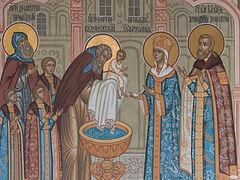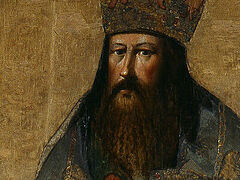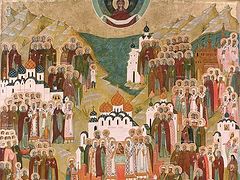 St. Gurius, Archbishop of Kazan and Svyazh, and Barsonuphius, Bishop of Tver and Kashin. Moscow, 17th c.
St. Gurius, Archbishop of Kazan and Svyazh, and Barsonuphius, Bishop of Tver and Kashin. Moscow, 17th c.
Sons of the Church Triumphant
426 years ago, Metropolitan Hermogenes of Kazan received information from the builders of the new Transfiguration Cathedral that while they were digging the trench for the foundation, they discovered the graves of Archbishop Gurius and Bishop Barsonuphius. The coffins were not destroyed, although thirty years had passed since Archbishop Gurius’s repose, and almost twenty years had passed since Bishop Barsonuphius’s.
Metropolitan Hermogenes arrived at the monastery and after the Liturgy and Pannikhida, he ordered that the coffins be opened, whereupon he identified the relics of archpastors whom he had known personally, was aware of their God-pleasing life, and cherished the most reverent memories of them.
St. Gurius’s coffin was filled with fragrant myrrh resembling pure water; moreover the saint’s relics were afloat at the surface of this liquid. Corruption had touched only part of the saint’s lips, while the rest of his body was completely whole.
Corruption touched only the soft parts of St. Barsonuphius’s feet, but the bones and tendons were firm, while the rest of his body was preserved in its entirety. Both of the pastors’ vestments were remarkable preserved, “better than new”.
Many great saints of Russian history participated in the lives and glorification of these saints, by far not the most famed and glorified. Tsar Feodor Ioannovich had ordered the construction of the church where the relics were discovered, and Holy Hieromartyr Hermogenes uncovered them. He also composed their first Lives. They were canonized by St. Job of Moscow. St. Gurius was consecrated a bishop by St. Makarius [of Moscow], and St. Barsonuphios was consecrated by St. Phillip [of Moscow]. St. Dimitriy of Rostov composed church services to them. A close disciple and successor to St. Gurius on the Kazan cathedra was St. Germanus, who was martyred most likely under Tsar Ivan the Terrible.
What path did Sts. Gurius and Barsonuphius take, what podvig brought them to the Church Triumphant?
St. Gurius: two years in a pit
 St. Gurius, Archbishop of Kazan. Holui, 19th c.
St. Gurius, Archbishop of Kazan. Holui, 19th c.
Both of the holy hierarchs had something in common from the very beginning of their life’s paths: They both endured great sorrows, and from those sorrows understood even from their youth the vanity of the world.
St. Gurius, in the world, Gregory, came from the ordinary “service folk”, and therefore was in service from his youth to Prince Penkov. The prince took note of the young Gregory’s virtue and diligence, and appointed him as steward of his household. It would seem that the young man had everything ahead of him—good prospects for “career growth”. But when envious courtiers slandered the youth in connection with the prince’s wife, the prince had Gregory thrown into a dungeon without any particular questioning—and it’s a good thing he didn’t kill him.
Yes, outbursts of jealousy deprive a man of his reason—although that’s a bad thing, it’s at least somewhat understandable… However, day after day passed, month after month, but the prince’s anger didn’t die down. Gregory remained in the dungeon.
Now, in medieval Russia prisoners were kept in earthen pits—something like root cellars lined with wood. In fact, the problem was not so much that prisoners were treated so cruelly but that innocent people could easily end up there—the tyranny of the “powerful of this world” was horrifying.
Gregory suffocated in the summer and froze in the winter in that pit. It was good if there was a bucket for wastes in it, and for food they threw him some unmilled oats… Not even bread and water, but unmilled grain!
After a while one of the guards took pity on the poor prisoner and tried to feed him at his own risk. But then it was discovered what spiritual advancement Gregory’s God-loving soul had reached through his suffering: He asked not for bread but for paper, ink, and pens. And then he wrote a grammar book for children, which the guard sold, at Gregory’s request given the money they earned to the poor.
After two years of imprisonment a miracle happened: The prison doors opened, and the prisoner left without anyone noticing. Once out he headed straight to a monastery.
Long imprisonment under such horrifying conditions could help a faithful person understand which harships he should consider real. It is no surprise that in the monastery Gregory was an example to all in obedience and every other virtue, and was not only tonsured a monk but soon became the monastery’s abbot.
Of course his imprisonment could not but affect his health, and after nine years as abbot, Gurius—as he was named in monasticism—went into retirement. But two years later he was again called back to the abbacy, and then appointed archbishop of the newly-opened Kazan diocese.
Holy Hierarch Barsonuphius: in captivity to the Tatars
 Holy Hierarch Barsonuphius, Bishop of Tver and Kashin. The Life of St. Barsonuphius began in a similarly tragic vein. At age seventeen, Ivan, as he was called before the tonsure, was taken captive during a Tatar raid and remained there for three years. He quickly came to terms with his misfortune, accepted it as God’s will, and spent the entire three years in an ascetic life. He worked for his masters not out of fear but conscientiously, and learned what was beneficial—including the Tatar language and literature—dedicating all his free time to prayer.
Holy Hierarch Barsonuphius, Bishop of Tver and Kashin. The Life of St. Barsonuphius began in a similarly tragic vein. At age seventeen, Ivan, as he was called before the tonsure, was taken captive during a Tatar raid and remained there for three years. He quickly came to terms with his misfortune, accepted it as God’s will, and spent the entire three years in an ascetic life. He worked for his masters not out of fear but conscientiously, and learned what was beneficial—including the Tatar language and literature—dedicating all his free time to prayer.
When after three years Ivan’s father purchased his freedom from captivity, the youth went straight to the St. Andronicus Monastery [in Moscow]. There he labored zealously in asceticism, and there he met another saint, Holy Hierarch Acacius of Tver, who foretold to Monk Barsonuphius that he would become his successor to the Tver cathedra.
Repose in Kazan
Any newly-opened diocese is both a consolation and a cross. It is a consolation because where nothing has yet been done, any labor is needed, and any effort is true. It is a cross because labor and effort in such a place are needed beyond measure.
In the diocese that sprang up on the ruins of Kazan, Archbishop Gurius’s stewardship talents came in very handy, as did Archimandrite Barsanuphius’s knowledge of Tatar culture. Needed also was their personal and profoundly tragic experience of renouncing everything earthly, their hearts softened by suffering, and their experience of consolation in Christ…
However, St. Gurius’s labors beyond his strength completely ruined his already undermined health, and he took to his bed. When his physical strength was utterly drained, Gurius’s co-laborer Archimandrite Barsonuphius tonsured him into the Great Schema, and three days later saw his much laboring soul off to a better world.
Barsonuphius himself was appointed four years later to the Tver cathedra. He labored there for three years, after which his health greatly deteriorated and he asked to be retired to his faraway former Monastery of the Transfiguration in Kazan. His heart cleaved warmly to his Kazan flock, and he reposed in their midst, being buried next to his instructor and guide, St. Gurius.
Nineteen years later, the future Hieromartyr Hermogenes received news from the builders of the Transfiguration Church, “Vladyko, we’ve dug up the buried holy hierarchs, and their coffins are not destroyed…”



